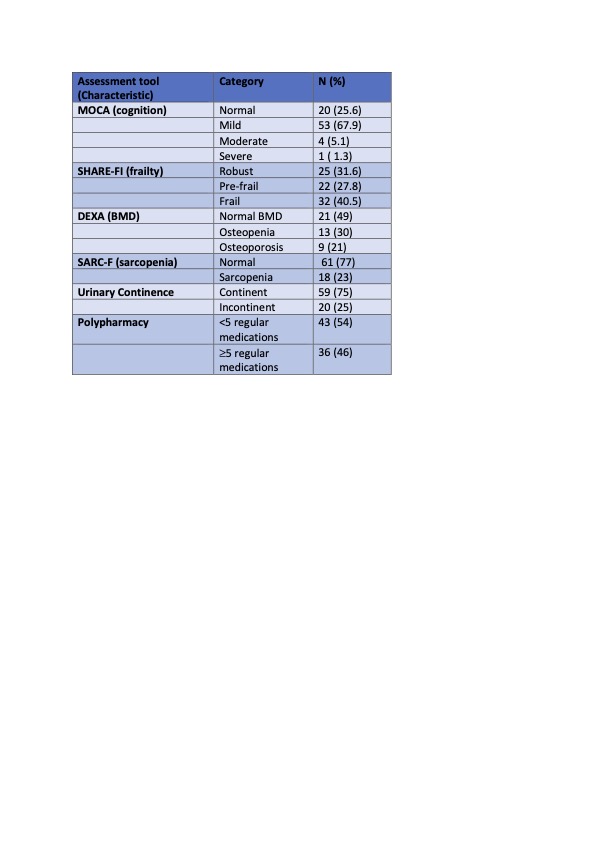Session Information
Date: Saturday, November 16, 2024
Title: Vasculitis – Non-ANCA-Associated & Related Disorders Poster I
Session Type: Poster Session A
Session Time: 10:30AM-12:30PM
Background/Purpose: Polymyalgia Rheumatica (PMR) is the most common inflammatory rheumatic disease in older adults, and aging has been postulated to be central to its pathophysiology. The objective of this study was to assess the prevalence of the physical phenotypes of aging in those newly diagnosed with isolated PMR.
Methods: Patients were recruited over a 12 month period from a multi-centre fast track PMR clinic. Frailty status was assessed using the SHARE-FI tool. Cognitive status was assessed using the Montreal cognitive assessment tool (MOCA), with a cut-off of < 26 used to define cognitive impairment. Bone mineral density was assessed using DEXA, whilst sarcopenia was assessed using the SARC-F questionnaire. Mood, anxiety, fatigue and pain were assessed using the PHQ-9. GAD-7, FACIT-F and pVAS screening tools respectively. Disease activity was assessed using the PMR-activity score (PMR-AS).
Normally distributed continuous variables are expressed as means with standard deviations (SD). Continuous variables are compared using the independent t-test. Categorical variables are summarised as frequency and percentage (%) and compared using chi-square test. The association between continuous variables and categorical variables is assessed using the Kruskal-Wallis test. The statistical analysis was performed using STATA MP Version 18. P values < 0.05 are considered statistically significant.
Results: 79 newly diagnosed patients (48% (n=38) female) were recruited. At baseline 40.5% (n=32) patients were frail, 27.8% (n=22) were pre-frail, and 31.6% (n=25) were robust. Increased frailty status was associated with a a significant difference in mean FACIT-F (p=0.00), pVAS (0.028), PHQ-9 (0.00) and GAD-7 (0.014) scores. 74.4% of patients had evidence of cognitive impairment at baseline. There was no significant difference between age, sex, BMI or disease activity across the different frailty or cognitive categories. 23% (n=18) had evidence of sarcopenia. 43 patients had baseline DEXA scans, with 21.4% (n=9) demonstrating osteoporosis, and a further 30% (n=13) osteopenia.
Conclusion: This study provides preliminary evidence for an accelerated physical aging phenotype in PMR. Further studies are needed to explore the role of inflammaging and immunosenescence in the pathophysiology of PMR.
To cite this abstract in AMA style:
Harkins P, Cowley S, McKittrick s, Harrington R, Kane D, Conway R. Evaluation of an Accelerated Physical Aging Phenotype in Newly Diagnosed Patients with Polymyalgia Rheumatica [abstract]. Arthritis Rheumatol. 2024; 76 (suppl 9). https://acrabstracts.org/abstract/evaluation-of-an-accelerated-physical-aging-phenotype-in-newly-diagnosed-patients-with-polymyalgia-rheumatica/. Accessed .« Back to ACR Convergence 2024
ACR Meeting Abstracts - https://acrabstracts.org/abstract/evaluation-of-an-accelerated-physical-aging-phenotype-in-newly-diagnosed-patients-with-polymyalgia-rheumatica/

